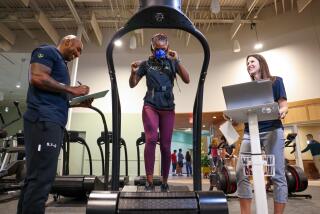Britain’s Health Club Industry Sees Gains Toward Greater Fiscal Fitness
- Share via
LONDON — Stuart Broster, managing director of Stakis Plc’s chain of LivingWell health and leisure clubs, has a novel pitch to sell Britons on his gyms: the more you work out, the more curry and beer calories you can afford to consume afterward.
The British are increasingly aware of the benefits of exercise, and thanks to one of Europe’s healthiest economies, they have more money to spend. That’s encouraging U.K. companies from Stakis to brewing giant Whitbread Plc, armed with different strategies, to enter what they consider a huge potential market for health and fitness clubs.
“We believe that the opportunity is on the order of 45 or 50 clubs, as quickly as we can do it,” said Steve Philpott, managing director of Whitbread’s David Lloyd Leisure, the U.K.’s biggest chain.
Health club participation in Britain is about half that in the U.S., where research group American Sports Data estimates about 8% of the population belonged to health clubs in 1995. Bally Total Fitness Holding Corp. alone, for example, has 330 fitness centers throughout the U.S. and Canada.
*
While the U.K. may never be as fitness-frenzied as America--where talk-show hostess Oprah Winfrey’s cook and personal trainer are celebrities in their own right--more Britons are hitting the gym. The Henley Centre, a U.K. research group, estimates 66% of the population will consider itself “health conscious” by 2000.
Ivan Reback, 63, is among the thousands of Britons who spend anywhere from 400 pounds ($656) a year to more than 1,000 pounds to stay in shape. Reback, a retired small-business owner, paid a one-time fee of 400 pounds and about 520 pounds per year to work out regularly at a David Lloyd Leisure club in Bushey, a suburb of London.
“We used to belong to another club, but it was very small and didn’t offer the same facilities,” he said. “Mainly we use the treadmill and go swimming, and we have a snack too.”
Health and fitness clubs will be a 850-million-pound market in 1997, and will grow to 1.06 billion pounds by 2000, according to marketing research company Mintel. Adjusted for inflation, that would represent growth of 27% since 1995, Mintel said.
Encouraged by those projections, and high consumer confidence, companies are “attacking the market,” said Tim Baldwin, an analyst with Greig Middleton & Co.
Whitbread’s other businesses, including brewing and the U.K. franchises of T.G.I. Friday’s and Pizza Hut, do more to expand the waistline than to shrink it. In 1995, Whitbread paid more than 200 million pounds for David Lloyd Leisure.
The company was founded in 1980 by Lloyd, the former Davis Cup tennis player, manager of the British Davis Cup team and Wimbledon doubles semi-finalist, and has the most members of any chain in Britain.
David Lloyd takes the “bigger is better” approach: A typical club sprawls across eight or 10 acres and includes eight indoor and six outdoor tennis courts, four badminton courts, three or four squash courts, separate indoor and outdoor swimming pools, a gym, health and beauty salon, bar and restaurant, and child-care facilities.
Operating profit from David Lloyd Leisure rose 50% in the six months ended in August. “We certainly expect to see a high rate of [profit] growth in the foreseeable future,” Philpott said.
Also vying to make Britons sweat is Stakis, the Glasgow-based hotel and casino company, which in May paid 19.8 million pounds for LivingWell. There are now about 60 of the clubs, some stand-alone and others in Stakis and Hilton hotels.
The company will focus more on facilities with up to 30,000 square feet with aerobics studios, weights, beauty salons and other services aimed at professionals, said Broster of Stakis.
“You’ve got to identify niche markets [like] stress management, nutrition, diet, beauty--the whole concept of health,” he said.
*
Fitness First, whose shares began trading in October and have risen 40% from their issue price, is staking out its own position, eschewing larger, more expensive facilities like tennis courts and swimming pools to focus on “affordable fitness.”
“We are building a chain of clubs that provide what we believe to be the most utilized facilities,” including aerobics classes, cardiovascular machines and weights, said Managing Director Michael Balfour, who gained his industry experience at the Houstonian Health and Fitness Club in Texas.
Its focused approach keeps membership costs low--the initiation fee is about 50 pounds and monthly dues are about 30 pounds. That compares to a one-time payment of up to 400 pounds, plus monthly fees of up to 70 pounds, at larger clubs. David Lloyd Leisure is now testing its own smaller, scaled-down clubs.
Other companies are jumping into the fitness fray. First Leisure Plc, which also operates nightclubs, bars, bingo clubs and bowling centers, will open six new health clubs this year, bringing its total to eight. It’s also planning a 55,000-square-foot Esporta Club in the Swiss Cottage neighborhood of London, set to open in 1998.
First Leisure is “certainly committed to being No. 2,” behind David Lloyd Leisure, said Simon Johnson, an analyst with BZW.
Meantime, Vardon Plc said it’s planning to further expand its string of Metropolitan clubs and Courtney’s gyms after paying 40.5 million pounds to buy the Archer health club business last July.
To be sure, to keep up the industry’s rapid growth, companies will have to focus on retaining customers as well as selling new memberships for a quick profit, Broster said. “You can get in for a fast buck or develop the business,” he said.
There’s a limit to the sales potential of “go for the burn” in the U.K., which explains the range of facilities and services being offered--and Broster’s curry and beer pitch.
“We say to people: ‘We understand you’re not going to put your shorts on and run the treadmill,’ ” he said, estimating that only about 5% of Britons are rabid fitness buffs.
“It’s the other 95% that I can empathize with,” he said with a laugh.
More to Read
Inside the business of entertainment
The Wide Shot brings you news, analysis and insights on everything from streaming wars to production — and what it all means for the future.
You may occasionally receive promotional content from the Los Angeles Times.










